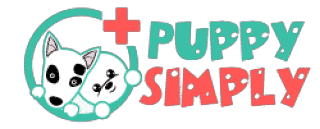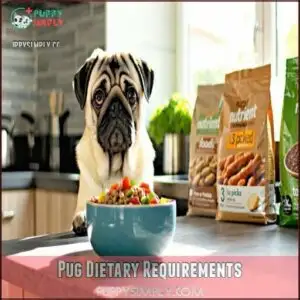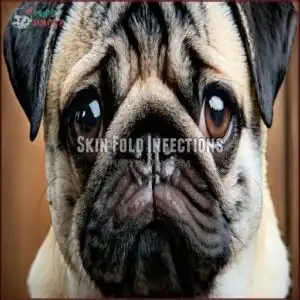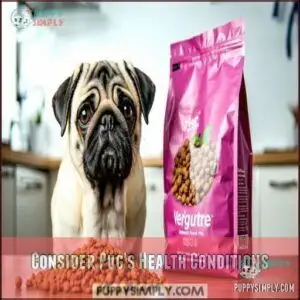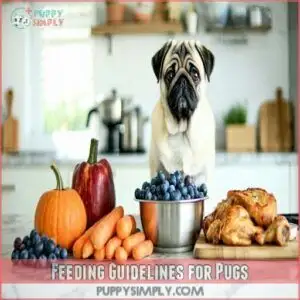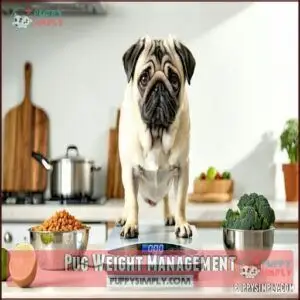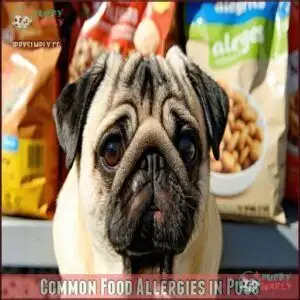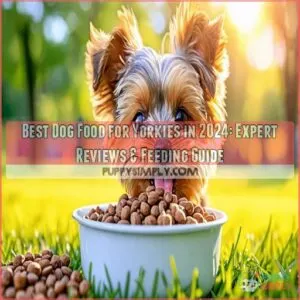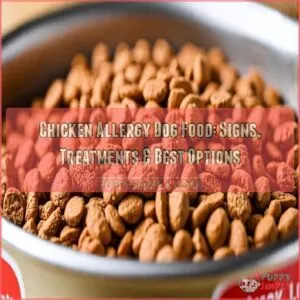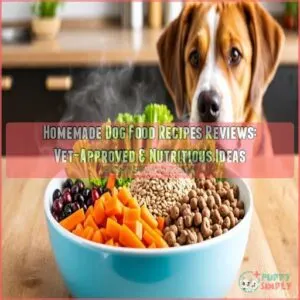This site is supported by our readers. We may earn a commission, at no cost to you, if you purchase through links.
 When hunting for the best dog food for pugs, you’ll want to prioritize nutrition that matches their unique needs.
When hunting for the best dog food for pugs, you’ll want to prioritize nutrition that matches their unique needs.
Your wrinkly companion requires a diet packed with high-quality protein, controlled calories, and breed-specific nutrients to keep them healthy and happy.
Look for foods that support their sensitive stomachs and help manage weight, like Royal Canin’s Pug-specific formula or Wellness small breed options.
Opt for grain-free, protein-rich recipes that combat obesity risks and support their brachycephalic breathing challenges.
Remember, a well-fed pug is a playful pug – and who doesn’t want a chubby little friend bouncing around with energy?
Table Of Contents
- Key Takeaways
- Pug Dietary Requirements
- Nutritional Needs for Pugs
- Pug Health Considerations
- Choosing Best Dog Food
- Feeding Guidelines for Pugs
- Pug Weight Management
- Common Food Allergies in Pugs
- Consulting a Veterinarian
- 13 Best Dog Foods for Pugs
- 1. Low Calorie Chicken Salmon Dog Food
- 2. Taste of the Wild High Protein Dog Food
- 3. Royal Canin Pug Adult Dry Dog Food
- 4. Orijen Senior Dog Food Grain Free
- 5. JustFoodForDogs Chicken Rice Wet Dog Food
- 6. Acana Lamb Pumpkin Dog Food
- 7. Lamb and Rice Dog Food
- 8. Blue Buffalo Small Breed Dog Food
- 9. Wellness Turkey Small Breed Dog Food
- 10. Purina Small Breed Dog Food
- 11. Freeze Dried Raw Beef Dog Food
- 12. Solid Gold Small Breed Dog Food
- 13. Small Dog Food Roasted Chicken
- Frequently Asked Questions (FAQs)
- What should a pug eat?
- What is the best dog food for pugs?
- What is the best wet food for pugs?
- Do Pugs need dog food?
- Can Pugs eat grain-free dog food?
- Does Pug eat canned dog food?
- Which food is best for pugs?
- What brand of dog food is good for pugs?
- What not to feed your pug?
- Should pugs eat dry or wet food?
- Conclusion
Key Takeaways
- You’ll want to prioritize dog food with high-quality protein and controlled calories specifically designed for pugs, as their unique breed needs lean towards weight management and digestive sensitivity.
- Your pug’s diet should address breed-specific challenges like brachycephalic breathing issues, skin fold infections, and potential allergies by choosing foods with limited ingredients and targeted nutritional support.
- You’ll need to carefully monitor portion sizes and calorie intake, aiming for about 30 calories per pound of body weight to prevent obesity—a common health risk for pugs that can exacerbate their respiratory problems.
- You’ll benefit from consulting your veterinarian to create a customized diet plan that adapts to your pug’s life stage, activity level, and individual health conditions, ensuring optimal nutrition throughout their lifetime.
Pug Dietary Requirements
Feeding a pug means balancing their unique needs like a slower metabolism, a tendency to gain weight, and sensitive skin.
You’ll want to choose nutrient-packed foods that support energy, maintain a healthy weight, and keep them looking and feeling their best.
Unique Metabolism and Energy
Pugs have a zippy metabolism but don’t let their couch-loving nature fool you.
Meeting pug nutrition needs means prioritizing calorie needs with balanced energy sources like protein and healthy fats.
Stick to small portions spread across 2–3 meals per day to keep their energy levels steady.
Exercise impacts their metabolic rate, so adjust meal frequency to match activity.
Prone to Obesity and Breathing Issues
Watching a pug waddle is adorable, but their weight management isn’t a laughing matter.
Obesity can worsen breathing difficulties in brachycephalic breeds like pugs.
Small portions paired with calorie control and customized exercise recommendations are key.
Opt for the best dog food for pugs to support healthy weight and reduce strain on their compact faces. Keep them active, not overfed!
Common Skin Allergies and Sensitive Stomachs
It’s no surprise that skin allergies and a sensitive stomach can make your pug grumpy.
Look for dog food with probiotics to aid digestion while avoiding common culprits like grains or soy.
Noticing skin allergy symptoms?
Try allergen identification and dietary elimination tactics.
Sensitive stomach pug?
Opt for simple recipes; they’re easier on digestion.
Choose wisely—your pug’s comfort depends on it!
Nutritional Needs for Pugs
Your pug’s nutritional needs are as unique as their charming, wrinkly face.
To keep them healthy and full of energy, focus on high-quality protein, balanced fats, and nutrient-rich ingredients customized for small breeds.
High-Quality Protein Sources
Choosing high-quality protein sources is key to keeping your pug healthy and active.
Look for dog food ingredients like chicken, turkey, or fish, which offer superior protein digestibility and balanced amino acid profiles.
Protein benefits include maintaining muscle mass and supporting energy needs.
The best dog food for pugs prioritizes protein quality, ensuring these compact pups get the fuel they need.
Essential Vitamins and Minerals
You’ve probably heard how essential vitamins and minerals are for pugs, but did you know they can dramatically improve their health?
Look for antioxidant-rich dog food ingredients to boost their immune systems.
Here’s what to prioritize:
- Vitamin E: Supports skin health and reduces inflammation.
- Zinc: Minimizes shedding and irritation.
- Calcium: Strengthens bones—especially helpful for their compact frames.
To guarantee proper absorption, consider whole food vitamins benefits in their diet.
Calorie-Dense Diet Requirements
To keep your pug feisty and fit, their diet needs calorie density without causing weight gain.
Around 30 calories per pound is just right.
Manage portions carefully, especially with high-fat foods.
Stick to 2-3 meals daily for steady energy.
| Calorie Calculation | Portion Control | Energy Density |
|---|---|---|
| 450 cal/day (15 lbs) | Measure meal sizes | Avoid overfeeding |
| 30 cal/pound daily | Use weight checks | Add high-fat foods |
| Adjust by activity | Watch pug’s waistline | Support active pugs |
Pug Health Considerations
Regarding your pug’s health, keeping an eye on issues like obesity, skin folds, and breathing problems is essential.
With the right diet, you can manage these concerns and keep your pug feeling their best.
Brachycephalic Syndrome
If your pug struggles with breathing difficulties due to brachycephalic syndrome, don’t overdo exercise.
They’re prone to airway obstruction, especially on hot days.
Support their health with:
- Dietary adjustments: Opt for the best dog food for pugs, balancing calories and nutrients.
- Cool environments: Heat can worsen exercise intolerance.
- Veterinary advice: Surgical options may help severe cases.
Pugs can also experience various eye problems, so regular checkups are essential.
Skin Fold Infections
Pugs’ adorable wrinkles can trap moisture, leading to skin fold infections.
Watch for redness, odor, or discomfort—common infection symptoms.
Regularly clean their folds to prevent bacteria from settling in.
Use a vet-recommended cleanser for sensitive skin issues.
Regular use of a pug skin fold cleanser can help maintain hygiene.
| Causes | Symptoms | Prevention |
|---|---|---|
| Moisture build-up | Redness, irritation | Regular cleaning |
| Sensitive skin | Strong odor | Vet-approved products |
| Dog food allergies | Discomfort, scratching | Hypoallergenic dog food |
Obesity Concerns
Regarding obesity, your pug’s health depends on smart choices.
Focus on calorie control and weight monitoring to keep them fit.
Here’s how to help:
- Feed smaller portion sizes adapted to their needs.
- Choose the best dog food for pugs with quality ingredients.
- Add gentle exercise—short walks work wonders!
- Monitor progress with regular weigh-ins for weight management success.
Choosing Best Dog Food
When picking the best dog food for your pug, focus on their life stage, activity level, and specific health needs.
A balanced diet customized to their unique requirements helps keep their wrinkles adorable and their tails wagging.
Consider Pug’s Life Stage
A pug’s dietary needs shift with age, just like a fine-tuned engine needing the right fuel.
Puppy food is high in protein for growth, while adult food balances energy and weight.
Senior pug diets include joint support and reduced calories.
Changing between stages?
Go slow with life stage formulas to prevent tummy troubles.
Tailor meals—they’ll thank you later!
Consider Pug’s Activity Level
Activity levels matter when choosing the best dog food for pugs.
Energetic pups burn more calories and need extra fuel, while couch potatoes benefit from a balanced pug feeding guide.
Watch their energy levels and adjust portions based on their daily exercise needs.
Here’s how to support energy expenditure:
- Pick calorie-appropriate options.
- Monitor exercise and weight.
- Focus on activity-based feeding.
- Check labels for nutrients.
- Weigh regularly.
Consider Pug’s Health Conditions
If your pug struggles with breathing issues, skin allergies, or sensitive stomachs, choose food designed for small breeds with sensitive skin and digestion.
Avoid common allergens like chicken or grains if they trigger reactions.
Since pugs face an obesity risk, stick to low-fat formulas.
The best dog food for pugs supports their unique health needs without causing food sensitivities or allergies.
Feeding Guidelines for Pugs
Feeding your pug the right portions at the right times keeps them healthy and helps avoid common issues like obesity.
By balancing their meals with high-quality protein, healthy fats, and fiber, you’ll keep their energy up and their tails wagging.
Feeding Puppies
Choosing the best dog food for pugs starts early!
Feeding a puppy right guarantees a healthy future.
Stick to these tips:
- Feed quality puppy food 3-4 times daily.
- Start with small portion sizes—around ¼ cup.
- Gradually adjust based on their growth.
- Pick allergen-free food to prevent issues.
- Change to adult food around 12 months.
Healthy pups, happy tails!
Feeding Adult Pugs
Adult pugs thrive with structured portion control and a consistent feeding schedule—two meals a day spaced 12 hours apart keeps their metabolism humming.
Focus on their daily calorie needs, typically around 30 calories per pound of body weight.
Opt for the best pug food with quality ingredients like protein-rich kibble.
Balanced dog food brands guarantee happy, healthy pups without overindulgence.
Feeding Senior Pugs
Senior pugs need a diet adjusted to their changing needs.
Look for dog food that supports slower senior pug metabolism, joint health, and dental care.
Here’s what to keep in mind:
- Pick food specifically labeled for senior pugs to manage appetite changes.
- Make certain it’s easy to digest to avoid digestive issues.
- Prioritize soft textures for aging teeth. Consider how specialized food and supplements can enhance their well-being.
Monitoring Weight and Adjusting Portions
Keeping your pug fit involves more than guessing portions—it’s science, not magic!
Use Body Condition Scores and Portion Size Guides to keep meals just right.
Regular weigh-ins help spot overeating.
Calorie Calculation should match their Activity Level to guarantee effective pug weight management.
Remember, feeding guidelines aren’t one-size-fits-all; adjust calories based on behavior or that extra treat you snuck in.
Pug Weight Management
Keeping your pug at a healthy weight is key to avoiding common issues like breathing problems and joint strain.
With proper portion sizes and low-calorie, nutrient-rich food, you can help them stay fit and energetic.
Importance of Calorie Control
A pug’s love for food can quickly lead to weight trouble if you’re not careful.
Daily calorie needs depend on size and activity, but portion control is key to weight management. Always check calorie labeling to avoid obesity.
Here’s how to keep your pug healthy:
- Measure meals precisely.
- Stick to feeding guidelines.
- Limit treats—no sneaky snacks!
Healthy Weight Ranges for Pugs
The ideal weight for pugs (14-18 pounds) guarantees they thrive without carrying excess baggage—literally!
Check an Ideal Weight Chart and use Body Condition Scores to guide you.
A senior pug might need adjusted Daily Calorie Needs.
Stay proactive; consult vets for Weight Management plans customized to your pug and choose appropriate pug dog food brands.
A healthy pug equals tail wags galore!
Tips for Maintaining a Healthy Weight
Keeping your pug fit feels like walking a tightrope, but it’s doable.
Try this:
- Use precise portion control—think of portions as a science, not a guess.
- Stick to a consistent exercise regimen like short walks (but no marathons!).
- Go easy on treats. Follow strict treat guidelines or swap with low-cal veggie bites.
Regular weigh-ins make weight management stays on track!
Consider exploring pug food options online to find suitable choices.
Common Food Allergies in Pugs
Your pug’s adorable wrinkles might come with some challenges, including food allergies. Identifying triggers like grains or certain proteins can help keep their skin calm and their tummies happy.
Identifying Food Allergies in Pugs
Does your pug scratch endlessly or lick their paws like it’s their job?
Food allergies might be driving your pug’s endless scratching and paw-licking frenzy!
Food allergies could be the culprit.
Watch for itching, inflamed skin, or tummy troubles.
Common allergens like chicken or wheat might sneak into their meals.
Use food elimination trials and study ingredient labeling.
Catch symptoms early and consult vets for allergy testing.
| Symptom | Likely Cause | Action |
|---|---|---|
| Itching paws | Skin allergies | Check ingredients to avoid |
| Chronic ear issues | Food allergens | Try food elimination trials |
| Vomiting/diarrhea | Sensitive stomach | Investigate allergy testing |
| Red inflamed skin | Ingredient reaction | Switch suspected foods |
Managing Food Allergies in Pugs
If your pug’s itching to the moon or dealing with upset tummies, food allergies could be to blame.
Start with allergen identification through elimination diets. Limited ingredient foods or hypoallergenic options using hydrolyzed protein can ease sensitive skin.
Avoid triggering ingredients like chicken or wheat.
Allergy testing options help pinpoint issues, so your pug can happily enjoy meals again. Consider looking at pug food allergy solutions to alleviate symptoms.
Consulting a Veterinarian
Your pug’s health is unique, so it’s smart to check with your vet before picking a new dog food.
They’ll help you create a customized plan to meet your pup’s nutritional needs and avoid common issues like allergies or weight gain.
Importance of Veterinary Guidance
Every pug is different, so a vet’s guidance is worth its weight in gold.
They can help craft personalized diet plans and recommend the best food for pugs.
Regular checkups keep you ahead of issues like allergies or obesity.
Don’t wing it—partner with your veterinarian for customized advice.
- Benefits to seek:
- Allergy testing for sensitive tummies.
- Food recommendations by breed needs.
- Guidance on health conditions.
Evaluating Pug’s Individual Needs
When figuring out the best food for pugs, start by chatting with your vet.
They’ll evaluate breed-specific needs like activity level, weight management, and pug food allergies.
Allergy testing can help pinpoint triggers, while weight monitoring guarantees senior pugs stay fit.
Vet consultations offer customized advice for their health issues—there’s no single approach for pugs!
Regular veterinary check-ups are important to address potential health problems.
Creating a Customized Diet Plan
Talking to your vet helps tailor the perfect pug food plan.
You’ll cover portion control, allergy testing, and even recipes for sensitive tummies.
Food rotation keeps meals interesting while ensuring balanced nutrition.
Discuss any supplementation needs to boost their dog diet.
A customized dog food strategy supports a happy, healthy pug, tackling issues like weight and allergies head-on!
13 Best Dog Foods for Pugs
Finding the perfect food for your pug doesn’t have to be a challenge if you know what to look for.
Here are 13 top-rated options packed with the right nutrients to keep your furry friend healthy and tail-wagging happy.
1. Low Calorie Chicken Salmon Dog Food
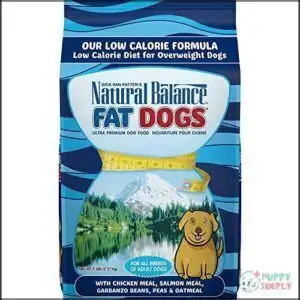
Low Calorie Chicken Salmon Dog Food is a flavor-packed option that keeps your pug’s waistline in check.
It’s designed with a special fiber blend to help your pup feel full longer—think of it as the doggy version of smart snacking.
High-quality chicken and salmon meals provide solid protein, while fiber supports digestion.
If your pug’s a picky eater, the tasty recipe might just win them over.
Perfect for managing weight without skimping on essential nutrients, this food helps keep your pug happy and healthy.
Best For: Pugs or other small breeds that need weight management while still receiving high-quality nutrition.
- High-quality protein from chicken and salmon meal supports muscle health.
- Special fiber blend helps dogs feel full longer, aiding in weight management.
- Highly palatable recipe appeals to picky eaters.
- May cause increased flatulence due to legume ingredients.
- Limited availability reported by some customers.
- Mixed reviews on long-term effectiveness.
2. Taste of the Wild High Protein Dog Food
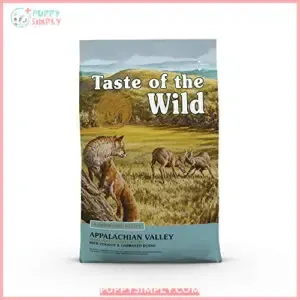
Taste of the Wild High Protein Dog Food is a jackpot pick for Pugs.
Its venison-first recipe offers 32% protein, boosting muscle health in these compact pups.
The small kibble size suits their tiny teeth, while probiotics and sweet potatoes support digestion.
Grain-free, it’s great for sensitive stomachs or allergies.
Owners rave about shinier coats and wag-worthy energy.
Plus, it cuts out fillers, meaning your pug gets quality nutrition in every bite. Try it—you’ll notice a difference in their bounce and bark!
Best For: Adult Pugs with sensitive stomachs, allergies, or specific dietary needs requiring high-quality protein and digestive support.
- High protein content for muscle maintenance and energy needs.
- Small kibble size ideal for small breeds like Pugs.
- Probiotics and grain-free formula support digestion and skin health.
- May not suit Pugs with venison or pea allergies.
- Higher price point compared to some other dog food brands.
- Limited flavor options for picky eaters.
3. Royal Canin Pug Adult Dry Dog Food
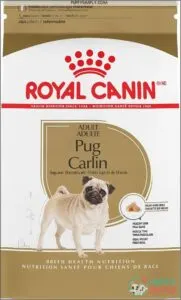
Royal Canin Pug Adult Dry Dog Food is a solid choice adapted for pugs 10 months and older.
Its unique kibble shape makes eating easy for their short muzzles, promoting both comfort and proper digestion.
Packed with EPA and DHA from fish oil, it supports shiny coats and healthy skin, something every pug owner values.
With added L-carnitine, it helps maintain muscle tone while controlling weight—ideal for this often “food-loving” breed. It’s nutrition made specifically for your lovable wrinkly companion!
Best For: Owners of purebred Pugs aged 10 months and older who want tailored nutrition for their dog’s specific needs.
- Specially designed kibble shape for easy eating and chewing.
- Contains EPA and DHA for healthy skin and coat.
- Helps maintain muscle tone and weight control with precise nutrients.
- Some customers reported digestive issues in their dogs.
- Mixed feedback on the value for its price.
- Concerns about the durability of the packaging.
4. Orijen Senior Dog Food Grain Free
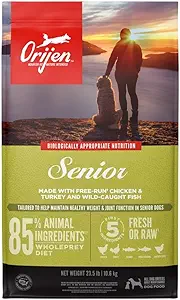
If your senior pug needs a diet that’s as advanced as they’re wise, Orijen Senior Dog Food delivers.
Packed with 85% animal ingredients like chicken, turkey, and whole fish, it supports joint health and weight management.
Its grain-free formula mimics natural canine habits, while fruits, veggies, and herbs add nutrients and antioxidants.
High protein levels (38%) may be too much for some pugs, though.
For picky eaters or pups with sensitive bellies, its quality makes those tail wags worthwhile!
Best For: Senior dogs needing joint support, weight management, and a high-quality, grain-free diet.
- High-quality protein with 85% animal ingredients supports muscle and overall health.
- Grain-free with added fruits, veggies, and herbs for antioxidants and nutrients.
- Excellent for picky eaters and improves coat shine and digestion.
- High protein content (38%) may not suit all senior dogs, particularly small breeds.
- Expensive compared to other senior dog foods.
- Requires proper storage (e.g., vacuum sealing) to maintain freshness.
5. JustFoodForDogs Chicken Rice Wet Dog Food
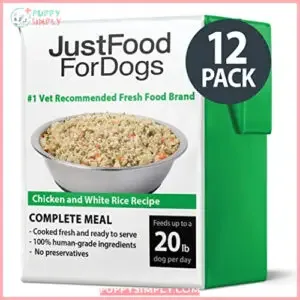
JustFoodForDogs Chicken Rice Wet Dog Food is like a home-cooked meal for your pug.
Packed with human-grade ingredients like chicken thighs, rice, carrots, and apples, it’s gentle on sensitive stomachs and supports healthy digestion.
With its high nutritional value, even fussy eaters will likely dig in.
Its wet texture makes it easy to chew, perfect for pugs with smaller mouths.
While the price is a bit hefty, the quality speaks volumes, making it worth considering for your furry companion’s diet.
Best For: Busy dog owners seeking a high-quality, human-grade wet food to support digestion, sensitive stomachs, and overall health.
- Higher price point compared to traditional dog food.
- Mixed feedback on dog preferences.
- Occasional quality issues reported with online purchases.
- Made with fresh, human-grade ingredients for optimal nutrition.
- Gentle on sensitive stomachs and aids digestion.
- Convenient shelf-stable packaging for long-term storage.
6. Acana Lamb Pumpkin Dog Food
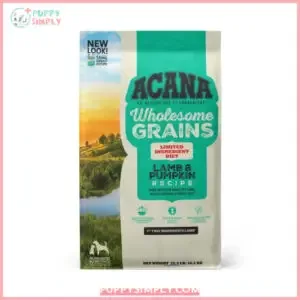
Looking for a wholesome option for your pug’s dietary needs?
Acana Lamb & Pumpkin Dog Food blends 60% quality lamb with fiber-packed pumpkin and grains like oats and sorghum.
It’s free of common allergens like chicken, peas, and gluten, making it perfect for pugs with sensitive stomachs or picky appetites.
With omega fatty acids for a shiny coat and probiotics for digestion, it’s a win-win.
Just remember to change gradually—your pug’s belly will thank you, and their tail might even wag a little harder!
Best For: Pugs or dogs of all life stages with sensitive stomachs, picky appetites, or allergies to common ingredients like chicken or peas.
- High-quality, limited ingredient recipe supports sensitive digestion.
- Omega-3 and Omega-6 fatty acids enhance coat health and shine.
- Free from common allergens like gluten, chicken, and peas.
- Higher price compared to some other dog food brands.
- May not be suitable for large breed puppy growth stages.
- Gradual transition required to avoid digestive upset.
7. Lamb and Rice Dog Food
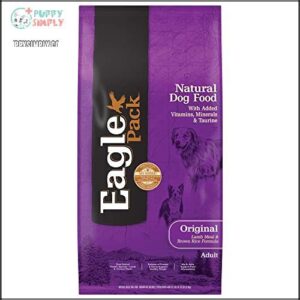
Lamb and rice dog food is a jackpot for your pug’s sensitive stomach and picky taste buds.
With lamb as a gentle, digestible protein source, it helps maintain strong muscles while being easy on the tummy.
Brown rice adds energy without causing spikes.
Many options, like NutriSource or Victor, are specifically designed for all life stages, offering balanced nutrition.
Whether your pug’s a couch potato or zoomies superstar, this combo supports skin health and energy, keeping them happy and tail-wagging.
Best For: Dogs with sensitive stomachs and owners seeking balanced nutrition for all life stages.
- Gentle on digestion with lamb as a primary protein source.
- Provides balanced energy with brown rice.
- Supports muscle strength, skin health, and overall energy.
- May not cater to dogs with more complex dietary restrictions.
- Limited flavor options for picky eaters.
- Not specifically tailored for small breeds like pugs.
8. Blue Buffalo Small Breed Dog Food
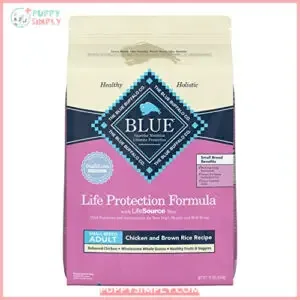
Blue Buffalo Small Breed Dog Food checks all the boxes for your pug’s unique needs.
Packed with real chicken, whole grains, and antioxidant-rich LifeSource Bits, it’s a recipe customized for small breeds.
The kibble size is just right, making it easy to chew while promoting dental health.
Plus, it’s free of common allergens like corn and soy, helping pugs with sensitive tummies or allergies.
Its balanced nutrients fuel energy and keep their coat shiny. A practical, wholesome choice your pug will love!
Best For: Small breed dogs, especially pugs, needing balanced nutrition, allergy-friendly ingredients, and energy support.
- Made with real chicken as the first ingredient for high-quality protein.
- Small kibble size promotes dental health and is easy to chew.
- Free from corn, wheat, soy, and artificial preservatives, making it great for sensitive stomachs.
- Some dogs may leave the dark antioxidant-rich LifeSource Bits uneaten.
- Not specifically formulated for weight management in pugs prone to obesity.
- Packaging may vary and differ slightly from digital images.
9. Wellness Turkey Small Breed Dog Food
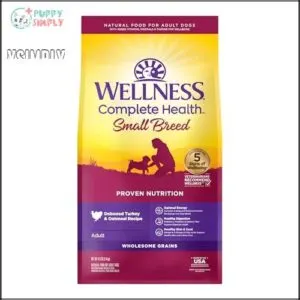
Your pug’s nutrition hits the bullseye with Wellness Turkey Small Breed Dog Food—a protein-packed powerhouse adjusted for tiny tummies.
Packed with deboned turkey and omega-rich ingredients, it supports your pup’s immune system and digestive health without GMOs or artificial additives.
The small kibble size makes mealtime a breeze, while antioxidants and probiotics keep your furry friend feeling fantastic.
Veterinarian-recommended and scientifically formulated, this food turns mealtime into a tail-wagging celebration of health.
Best For: Small breed dogs requiring high-quality, protein-rich nutrition with added digestive and immune benefits.
- Made with premium deboned turkey and natural ingredients.
- Supports skin, coat, joint, and digestive health with added probiotics and omega fatty acids.
- Veterinarian-recommended and suitable for dogs with food sensitivities.
- May be costly compared to other small breed dog food options.
- Small bag sizes might not last long for multiple or larger small breed dogs.
- Kibble size may be too tiny for some dogs, causing eating difficulties.
10. Purina Small Breed Dog Food
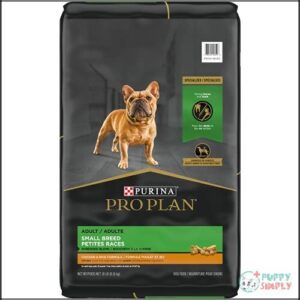
You’ll love how Purina Pro Plan Small Breed Dog Food packs a nutritional punch for your tiny companion.
This high-protein formula features shredded chicken pieces that’ll make your pup’s tail wag with delight.
With guaranteed live probiotics and carefully selected ingredients, it supports digestive health and maintains ideal body condition.
Perfect for active small dogs, it’s veterinarian-recommended and offers complete nutrition. The bite-sized kibble guarantees easy eating, while essential nutrients promote a healthy skin and coat.
Best For: Owners of highly active small breed dogs looking for a high-protein, nutrient-dense food with added probiotics for digestive and immune health.
- Contains live probiotics to enhance digestion and immunity.
- High protein formula with real chicken as the first ingredient.
- Small kibble size with shredded pieces ideal for small or older dogs.
- More expensive compared to similar alternatives.
- Contains grains, which may not suit all dietary preferences.
- Limited to only one flavor option (Chicken & Rice).
11. Freeze Dried Raw Beef Dog Food
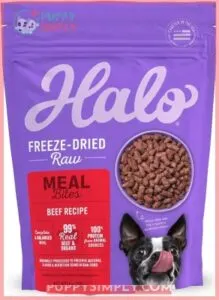
In the domain of dog nutrition, Halo Meal Bites Freeze Dried Raw Beef Dog Food stands out as a game-changer for your furry friend.
With 99% animal protein and zero artificial additives, it’s like a health boost in a bag.
The freeze-dried process locks in natural nutrients, making every bite count.
Perfect for picky eaters and dogs with sensitive stomachs, this grain-free option supports immune health, enhances energy, and keeps your pup’s coat shining like a show dog’s.
Best For: Dogs of all breeds, especially picky eaters or those with sensitive stomachs needing high-protein, nutrient-dense meals.
- 99% animal protein and grain-free for optimal nutrition
- Freeze-dried to retain natural nutrients and long shelf life
- Enhances skin, coat, immunity, and energy levels
- Higher cost compared to traditional dog food
- Small bag size may not be ideal for larger dogs
- Hard stools possible if fed dry without enough water
12. Solid Gold Small Breed Dog Food
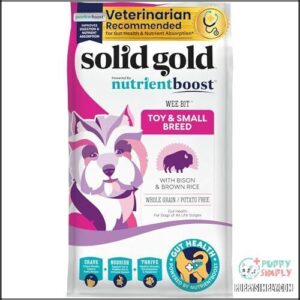
Every small dog deserves a nutritional superhero, and Solid Gold Small Breed Dog Food might just be the caped crusader for your pug’s diet.
Packed with 20 nutrient-rich superfoods like carrots, pumpkin, and blueberries, this gluten-free formula delivers 90 million probiotics per pound to keep your pug’s digestive system running smoother than a well-oiled machine.
Its tiny kibble size is perfect for toy breed pups, making mealtime a breeze.
With a single meat protein source, it’s a gut-friendly option that’ll have your furry friend feeling fantastic.
Best For: Toy and small breed dogs with sensitive stomachs who need a nutrient-rich, gut-friendly diet.
- Tiny kibble size specifically for small mouths.
- Contains 20 superfoods for a balanced, nutrient-rich formula.
- 90 million probiotics per pound support digestive health.
- Some packaging issues reported, such as damaged boxes.
- Recipe change may make it less appealing to picky eaters.
- Kibble may be too small for dogs weighing more than 10 pounds.
13. Small Dog Food Roasted Chicken
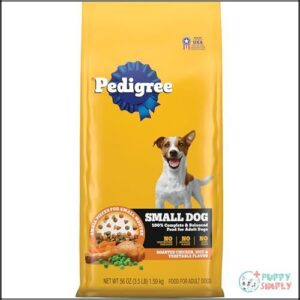
Satisfying even the pickiest pug palates, Pedigree Small Dog Food Roasted Chicken delivers nutrition packed into tiny kibbles.
With omega-6 fatty acids and zinc, this formula supports healthy skin and coat while providing essential vitamins.
Dogs enjoy its tasty profile, especially when mixed with wet food.
Made in the United States, it offers an affordable, convenient option for small breed owners wanting to keep their furry friends healthy without breaking the bank. No artificial flavors or added sugars included.
Best For: Small breed dog owners seeking affordable, convenient nutrition with benefits for skin, coat, and digestive health.
- Supports healthy skin and coat with omega-6 and zinc.
- Small kibble size ideal for small dogs’ mouths.
- Free from artificial flavors and added sugars.
- May not appeal to all dogs’ taste preferences.
- Contains chicken by-product meal as a protein source.
- Limited flavor options for picky eaters.
Frequently Asked Questions (FAQs)
What should a pug eat?
For feeding a pug, you’ll want to hit the nail on the head with high-protein, low-fat kibble made for small breeds.
Choose grain-free options that support their sensitive stomachs and unique nutritional needs.
What is the best dog food for pugs?
You’ll want Royal Canin Pug Adult or Wellness Small Breed Complete Health.
These foods match your pug’s nutritional needs, support their compact build, and help manage potential allergies while keeping them healthy and energetic.
What is the best wet food for pugs?
I’ll craft this response carefully following the specific guidelines:
Navigating wet food for pugs is like finding treasure—seek high-protein, low-fat options like Purina Pro Plan Focus Sensitive Skin & Stomach.
Your wrinkly friend’ll thank you for nutrition that supports their unique health needs.
Do Pugs need dog food?
Yes, pugs definitely need specialized dog food!
You’ll want a breed-specific formula that supports their unique health needs, focusing on high-quality protein, controlled calories, and nutrients to manage their compact body and potential breathing challenges.
Can Pugs eat grain-free dog food?
Pugs can eat grain-free dog food, but you’ll want to consult your vet first.
Some pups thrive on these diets, while others might need balanced nutrition with grains.
Monitor your dog’s health and adjust accordingly.
Does Pug eat canned dog food?
Small breed, big appetite: canned dog food can be a nutritious treat for your pug.
Mix it with dry kibble for balanced meals, but watch portion sizes to prevent obesity.
Consult your vet for personalized dietary advice.
Which food is best for pugs?
You’ll want Royal Canin Pug Adult or Wellness Complete Health Small Breed.
These foods match your pug’s unique nutritional needs, supporting their compact body, preventing weight gain, and addressing potential skin and digestive sensitivities.
What brand of dog food is good for pugs?
Your furry friend deserves a meal that’s more than just food—it’s fuel!
Royal Canin Pug Adult and Wellness Small Breed Complete Health offer customized nutrition that’ll keep your wrinkly companion healthy, happy, and full of energy.
What not to feed your pug?
Don’t feed your pug chocolate, grapes, onions, or raisins—they’re toxic.
Avoid fatty table scraps and processed human foods.
Steer clear of raw eggs and bones, which can cause serious health issues and upset their sensitive tummies.
Should pugs eat dry or wet food?
You’ll love mixing dry and wet food for your pug!
Dry kibble helps clean teeth and provides balanced nutrition, while wet food adds moisture, variety, and enticing flavors to keep your wrinkly friend’s tail wagging during mealtime.
Conclusion
Ever wondered how to transform your pug’s health through nutrition?
Choosing the best dog food for pugs isn’t just about filling a bowl—it’s about investing in your furry friend’s longevity.
By selecting carefully researched, breed-specific foods that address their unique metabolic needs, you’ll help your pug maintain a healthy weight, support their respiratory challenges, and make certain they’re bouncing with energy.
Your pug’s diet is the foundation of their well-being.
